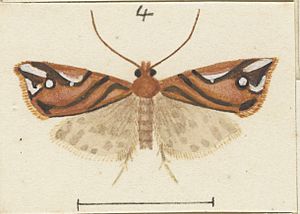Pyrgotis plinthoglypta facts for kids
Quick facts for kids Pyrgotis plinthoglypta |
|
|---|---|
 |
|
| Scientific classification | |
| Kingdom: | |
| Phylum: | |
| Class: | |
| Order: | |
| Family: | |
| Genus: | |
| Species: |
P. plinthoglypta
|
| Binomial name | |
| Pyrgotis plinthoglypta Meyrick, 1892
|
|
| Synonyms | |
|
|
The Pyrgotis plinthoglypta is a type of small moth that belongs to the Tortricidae family. This moth is special because it is found only in New Zealand. Scientists call this "endemic," meaning it lives naturally in just one place.
Contents
Discovering the Moth
This moth was first described by a scientist named Edward Meyrick in 1892. When a scientist "describes" a species, it means they officially name it and write down all its features for the first time.
What Does This Moth Look Like?
The Pyrgotis plinthoglypta moth is about 16 millimeters wide when its wings are spread out. Its head and mouthparts are a light reddish-orange color. The main part of its body, called the thorax, is also reddish-orange and has a dark, curved mark.
Its front wings are long and shaped like triangles. They are mostly a pale reddish-brown color with irregular spots that are more orange. These markings are often mixed with black and a rusty red color. The patterns on the wings are quite detailed, with several streaks and small spots. The good news is that these wing patterns usually look the same on all moths of this species.
Where Does This Moth Live?
This moth is found only in New Zealand. It lives all over the country and is considered to be a common species.
Moth Behaviour
Adult Pyrgotis plinthoglypta moths can be seen flying from October all the way through May. These moths are active at night, which means they are "nocturnal." Like many night-flying insects, they are often drawn to lights.
Habitat and Food
This moth species lives in native forests. The young moths, called larvae or caterpillars, feed on a specific tree. They eat the leaves of the Rimu tree, which is a large evergreen tree native to New Zealand.
Images for kids


